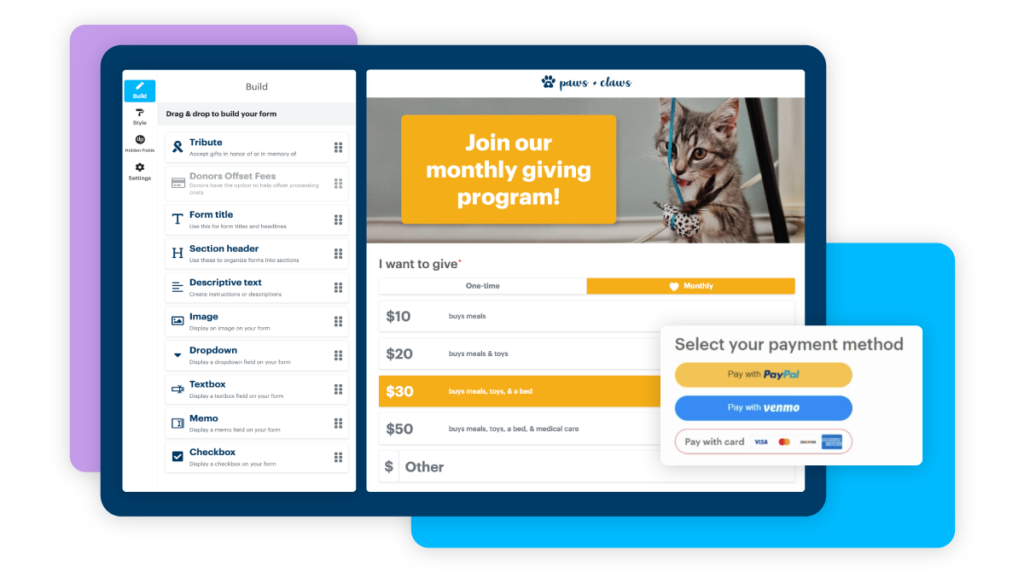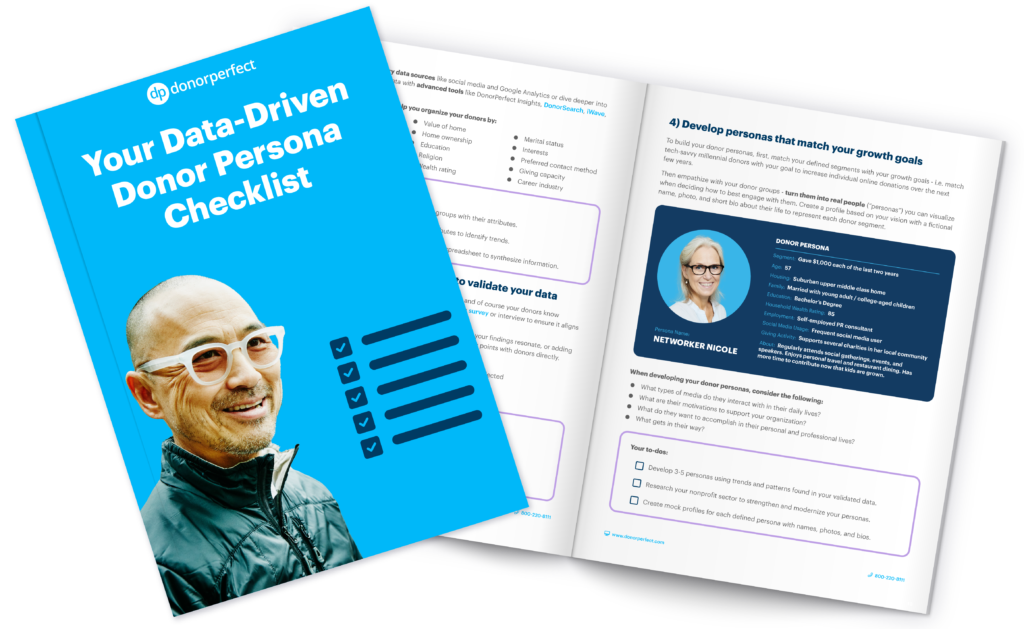Nonprofit Technology & Fundraising Blog
Subscribe to our mailing list

March 16, 2023 | Donor Retention
Last year, you and your team worked tirelessly to meet your fundraising and donor acquisition goals. As the year passes, you slowly see the progress you made trickle away as each new donor you acquired fails to respond to this years’ appeals. Fundraising can seem like a frustrating and insurmountable game when facing a high rate of donor churn. It can also seem like a mystery as to why you’re losing donors. After all, you must have done something right when you first acquired them.
You can’t estimate your donor retention rate by looking at your year-over-year revenue. Fortunately, many modern CRMs make it easy to determine your donor attrition rate. DonorPerfect builds the calculation right into its Comprehensive Donor Revenue Analysis report and places your donor retention rate metric right on your giving metrics dashboard.
Perhaps I can lend some insight into where all of your donors are going. After I got my degree, I worked for a nonprofit organization. I know firsthand how tirelessly fundraisers work at a financially strained organization. Since then, I consistently make charitable donations about twice a month. However, there are few charities I’ve donated to with any regularity, and I’ve only very recently become a monthly donor to two charities. While my perspective is just one, I’ve found that I’m a pretty typical donor when it comes to the reasons why I’ve stopped giving to charities. So here’s a firsthand account of why donors may be leaving your nonprofit.
The donation process to a nonprofit I supported felt a bit underhanded. I had made what I intended to be a one-time donation to a charity only to discover a few months later when looking at my bank statement that it was indeed a monthly subscription. When going through the transaction process, monthly giving was the default setting on their giving form, and during the confirmation process, there was no clear indication that it was a monthly gift. Feeling as though I had been taken advantage of, I reached out to cancel my subscription and have never donated to that organization again. Nor do I intend to lend my support to them again.
Don’t let my blunder hold you back from acquiring monthly donors. DonorPerfect’s online giving forms alert your donors to their monthly donation each step of the way from the donation form to the confirmation page and the receipt.

This may not be of particular concern for your nonprofit, especially if you do not have monthly giving set as the default option on your giving forms. Still, it is critical that you make it abundantly clear when a donor is subscribing to your monthly giving program. There are other factors that may make a donor feel uneasy about giving to you. These could include things like unbranded donation forms, an unsecured site connection, or not knowing how you intend to use their funds.
Instill confidence and trust in your donors by ensuring you have a straightforward donation process. Customize your online forms to match your organization’s brand, and follow up all donations with a concise and truthful summary of how you have used or plan to use their donation.
When I was 19, I received a considerable sum of money from a lawsuit where I had injured myself in a car accident. I donated much of this settlement to a charity in which I then became involved. Over the years, I would see countless appeals from their nonprofit. Despite my dedication to their cause, I always felt embarrassed to give again because I knew any secondary gift I made would not come close to my initial contribution. Now, this is a somewhat unique circumstance, but you can apply the basic takeaway strategy to countless donors.
At one point, a donor may have made a gift to your organization at a specific giving level, and now the targeted messaging you are sending lists giving levels that fall out of their financial reach. While it is so vital to not underestimate a donor’s generosity, it is just as important to remind donors that smaller gifts make a big impact as well.
When donors lapse, strategize by sending them smaller ask amounts or asking them to become a monthly donor, where they can make a bigger impact over time.
I have to admit, I thought I was the only one who frequently forgot about the organizations they’ve given to until I started researching causes of donor attrition. This is one of the top reasons why donors stop giving. They’ve simply forgotten they ever supported you in the first place.
There are a number of reasons why I may have forgotten, including, but not limited to:
Truth be told, some of these organizations could have done everything right and I still would not have remembered giving to them. But, in many instances, these organizations would have benefitted from a thank you that stood out, better branding, and follow-up communication. For example, I have never made a tribute donation, and later been informed how much money was raised in honor or memory of a loved one. It would be wonderful to know how gifts in memory or honor of someone I love and respect have made a difference to a cause that meant so much to them.
Don’t let one-time donors who find your cause through events like Giving Tuesday lapse. Check out DonorPerfect’s Welcome Wednesday tips to gather some strategies for engaging your new supporters. You can apply a lot of these tips to tribute donors, too.
There have been many times when I’ve been scrolling through social media on my phone at night and have seen a cause that I felt was worthy of a contribution. However, there have not been many causes that have been so worthy as to inspire me to get out of bed or to remember to make a donation in the morning when I have my credit card handy.
On the other hand, donation forms that let me use my PayPal account have always received my support if I’ve made it that far along in the donation process.
Hopefully, most of your donors aren’t as lazy as I am, but removing complications from the donation process is still a lesson you can and should apply. Look through your giving process thoroughly and remove any roadblocks that you can. Limit required fields on online forms and offer a variety of ways to make a donation. This is especially essential for contributors looking to donate complicated assets. Make sure your organization is ready and willing to receive donor-advised funds, which can simplify the giving process for your most affluent supporters.
DonorPerfect’s online giving platform lets your donors contribute with a digital wallet, simplifying the donation process for them.
We’ll come back to this one again, but there is a local organization in my neighborhood that I support on a monthly basis now. However, I did not know about the need or the organization despite living in the community where they reside, and amongst the population they serve. In fact, the only reason I discovered them at all was that I work for an organization that supports them as a client.
In all likelihood, had I not had the experience that I did with the organization, I would have made a one-time donation and moved on. Donors who contribute to a single appeal to support a specific campaign need to know there is an ongoing effort that requires their support. What may seem obvious to you is not necessarily clear to donors who have made one-time donations to your nonprofit.
Along with telling your donors about the great work you have accomplished with their help, you also want to communicate how important their continued support is. You can do this by telling them about your upcoming goals or your projections for how many you will serve in the coming years. Also, try a variety of methods such as social media, email, direct mail, and even ads to share your needs.
Ok, time for another confession. I have never written off a nonprofit because I did not receive a follow-up thank-you email or letter, but I had to include this on the list because statistics show this is a vital step in the donor retention journey. Most of the time, I don’t pay attention to whether or not I have received a thank you – unless I’m unsure that my donation was successfully processed.
That doesn’t mean you’re off the hook for sending thank yous, though. For one, I think it’s just good manners to acknowledge a donor’s contribution, but there are other really good reasons to send one as well.
Speaking of which, you don’t need to make a second ask in your thank you, but it’s also really important not to wait too long. Research shows that there is a science behind getting donors to give a second gift. Donors who make a second gift are significantly more likely to continue to support your organization.
If you’re not sending targeted messages, chances are your communications to donors are ending up in their trash can (physical or virtual). I get sent (and this is not an exaggeration) about ten to fifteen pieces of direct mail a week from nonprofit organizations. I do not open any of them. Granted, I am a millennial donor, and my preferred method of communication is not direct mail. But that’s kind of the point. I receive piece after piece of direct mail from the same organizations that I haven’t donated to in ages. Not only are they wasting their funds on me, they’re not paying attention to donor preferences.

Segmenting your communications is vital to a successful fundraising strategy. If you’re feeling at a loss, invest in some much-needed information from donor prospect research. You’ll see a startling return on investment when you know more about your donors.
Now that I’ve made my confession, there are some strategies that have kept me coming back to organizations that I’d like to share with you.
There are two organizations to which I make very small recurring donations. One is the International Rescue Committee. I don’t know how they’ve engineered this, but every single time I make a purchase using my PayPal account, their name pops up, requesting a $1 donation. Without fail, every single time I make a purchase using PayPal, they receive a dollar donation from me.
The other organization I donate to is a local food pantry. They have partnered with my grocery store, and every time I check out, the register asks me if I would like to round up my transaction to the nearest dollar to support them. It’s a few extra cents that I am happy to contribute.
The common denominator for both of these organizations is how easy they’ve made the donation process (it probably helps that they are asking for a very small amount of money as well.) I don’t have to take any extra steps (other than clicking yes, or checking a box) to make my donation.
Next, there are two organizations to which I make regular monthly contributions, but my reasons for giving to each are vastly different. The first is an organization that supports dogs and their medical needs. I make a small $5 dollar donation and my motivator is pretty selfish. By being a part of their monthly donor club, I get exclusive emails that include pictures of adorable dogs. It’s a win-win in my book. I support a cause near and dear to my heart and get a heartwarming message in my inbox. Without this incentive, I’m sure I would have supported the cause anyway, but most likely not on a monthly basis.
The other organization is the local community nonprofit that I didn’t know anything about. To be honest, they’ve done a lot wrong in cultivating me as a donor, but they did one important thing right. When I first reached out to this organization, it was with the intent of volunteering for them. As part of their volunteer process, they hosted a one-on-one orientation. It was just a Zoom meeting (due to COVID) between myself and their volunteer coordinator. This staff member is one of their biggest assets because he’s passionate about their cause. He spoke to me of the need in my own community in a very moving way. I didn’t become a volunteer that night, but, all it took was a single person-to-person conversation with a passionate advocate of their cause for me to become a $50 monthly donor. For those of you who are reluctant fundraisers, he didn’t even ask me for money. (One 60-minute conversation has led to a $600 per year donation. That’s a pretty great return on investment if you ask me and my subscription is still ongoing.
Disclaimer: This is just the perspective of one delinquent donor, but if you can keep someone like me coming back, you will have solved your donor attrition problem. For more tips on donor retention, get your copy of DonorPerfect’s Donor Retention Toolkit.
Follow us on social!